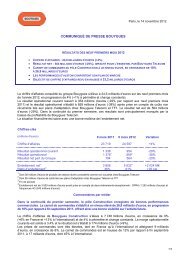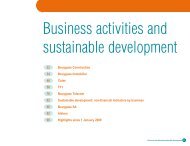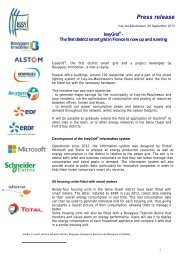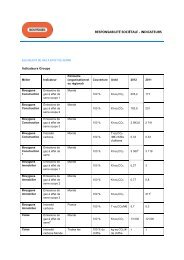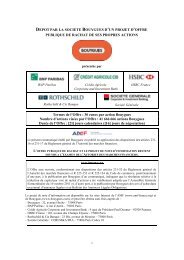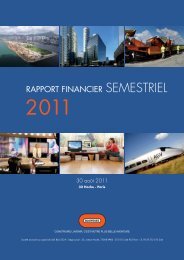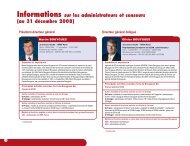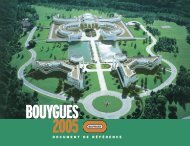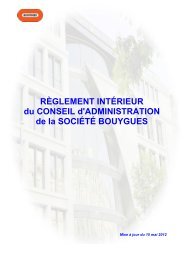Registration Document BOUYGUES
Registration Document BOUYGUES
Registration Document BOUYGUES
You also want an ePaper? Increase the reach of your titles
YUMPU automatically turns print PDFs into web optimized ePapers that Google loves.
3<br />
Risk factors<br />
Business-specific risks<br />
This is also true of operational functions, which are<br />
organised into different branches, such as legal,<br />
human resources, accounting, management control,<br />
IT systems and purchasing, which are coordinated<br />
by Bouygues Construction departmental<br />
heads. Functional expertise units, handling matters<br />
such as cash management, financial engineering,<br />
taxation and insurance, all provide their services to<br />
all group companies.<br />
The approval and control procedures prepare the<br />
ground for the design and construction processes.<br />
For major projects, there is a systematic monitoring<br />
of project selection and the key risks involved.<br />
The main operational risks are also mitigated<br />
by adequately-staffed project teams that have<br />
the requisite professionalism. This is combined<br />
with managerial experience and active manager<br />
involvement.<br />
In addition, to improve the performance and control<br />
of the design and execution processes described<br />
in the operational unit management systems:<br />
> the major project pre-execution phase is a particular<br />
focus of attention, especially in the design<br />
phase, the drafting of contracts and preparation<br />
of the worksite;<br />
> in the design phase, independent consultants<br />
are used to back up in-house expertise on the<br />
riskiest technical projects;<br />
> regular costing audits are carried out to ensure<br />
a reliable approach in terms of general outlay,<br />
subcontractor budgets and worksite supervision<br />
costs;<br />
> the support functions are systematically mobilised,<br />
in particular for contract management and<br />
purchasing, and those assisting are involved<br />
early on in the process;<br />
> there is increased vigilance of the selection and<br />
overseeing of customers and partners;<br />
> the subcontracting process is tightly-supervised,<br />
with special oversight of major subcontractors<br />
and partnerships before the allocation of<br />
high-stake work packages (architects, technical<br />
trades, etc.);<br />
> risks are appropriately monitored using purposedesigned<br />
tools and procedures. To this end,<br />
some entities have adopted formal risk management<br />
systems specific to the largest projects. At<br />
Bouygues Travaux Publics, the global quality<br />
division manages this process.<br />
In 2011, no significant operational risks materialised.<br />
However, two projects are a focus of special<br />
attention in South Africa (Gautrain project) and<br />
the US (Miami tunnel project). A more detailed<br />
analysis of these cases is given in the claims and<br />
litigation section.<br />
Country risk<br />
Bouygues Construction generates 55% of its business<br />
in France and 77% in OECD countries.<br />
The risks to which the group is exposed outside<br />
these areas are either political, deriving from governmental<br />
actions or decisions taken at the local<br />
level (embargoes, asset seizures or the freezing of<br />
bank accounts), social (general strikes, civil disturbances),<br />
economic or financial (currency devaluation,<br />
currency shortages or a payment default).<br />
Bouygues Construction uses a variety of means to<br />
limit these risks. Thorough investigations are conducted<br />
before prospecting for business in a new<br />
country. It is company policy to suspend commercial<br />
activities in regions with a particularly serious<br />
political risk, and not to prospect for business in<br />
countries presenting the highest risk (in particular<br />
those experiencing serious civil or military unrest,<br />
or subject to United Nations embargoes). The<br />
company also operates preventive legal, financial<br />
and insurance measures, in particular ordering<br />
the systematic cessation of a worksite in a case of<br />
non-payment, preferring multilateral international<br />
financing and procuring political risk insurance<br />
cover whenever it is available on the insurance<br />
market on satisfactory financial terms.<br />
Regularly-updated business continuity plans are<br />
also in place. A key aim of such plans is to safeguard<br />
people. Bouygues Construction ensures<br />
that the guidelines issued by French embassies<br />
are strictly followed in the countries concerned. It<br />
also liaises with the embassies to develop evacuation<br />
plans for various alert levels. In addition, the<br />
group's flexible organisational structures make it<br />
possible, in exceptional circumstances, to withdraw<br />
its resources from countries where such risks<br />
materialise while keeping its losses to a minimum.<br />
The political disturbances that marked 2011 in<br />
many countries had only a limited impact on<br />
company's business and personnel. The most<br />
significant of these upheavals took place as part<br />
of the "Arab Spring". Bouygues Construction has<br />
only limited involvement in this region, other than<br />
Morocco, an adjoining country, and Egypt. In<br />
Egypt, all of the teams working on the Cairo Metro<br />
were repatriated when the crisis was at its height.<br />
The unrest following the presidential election in the<br />
Ivory Coast caused a slowdown in the local activities<br />
of ETDE and disruption in the mining activities<br />
of DTP Terrassement. These events did not prompt<br />
any serious incidents and business has since<br />
resumed as normal, particularly with the revival of<br />
the project to build a third bridge in Abidjan.<br />
Recession-related risk<br />
The public debt crisis and stagnation in the building<br />
and civil works sector is having a significant<br />
impact in many EU countries where Bouygues<br />
Construction generates 68% of its sales. Despite<br />
good business levels, price pressures are being felt<br />
and the group is having to cope with the growing<br />
vulnerability of some of its counterparties.<br />
In Europe, the economic environment is marked<br />
by a reduction in public spending, growing hesitation<br />
by private investors and severe constraints<br />
on project financing transactions. The end of the<br />
housing support programmes and the fall in public<br />
investments are dampening business. Building<br />
and civil works sector growth remained in the<br />
red in 2011.<br />
Like many companies in the industry, Bouygues<br />
Construction is finding it increasing difficult to get<br />
bank financing to secure complex transactions.<br />
Bouygues Construction may at times be faced<br />
with specific problems connected with delays or<br />
the abandonment of some construction projects,<br />
and difficulties in obtaining payment for projects<br />
currently in progress.<br />
Nevertheless, the group has many strengths to<br />
resist and adapt to the economic climate. Its business<br />
diversity and geographical footprint mean<br />
that Bouygues Construction is less sensitive than<br />
a group engaged in a mono-product business or<br />
in a single geographical region.<br />
Bouygues Construction also enjoys a protected<br />
business environment in certain countries or for<br />
some types of activity. This is the case in Asia,<br />
in the countries where business is traditionally<br />
done (Hong Kong, Singapore) but also in Central<br />
America, in Cuba, where a growing tourist industry<br />
<strong>BOUYGUES</strong> • 2011 <strong>Registration</strong> <strong>Document</strong> • RISK FACTORS • 137



